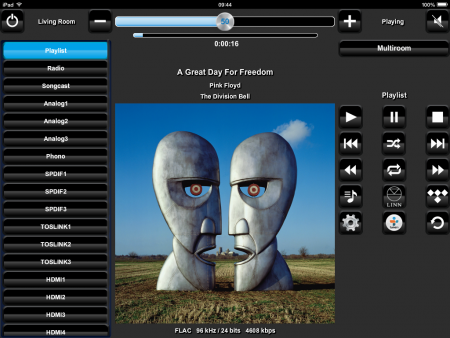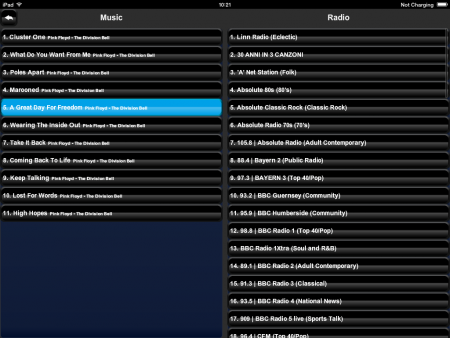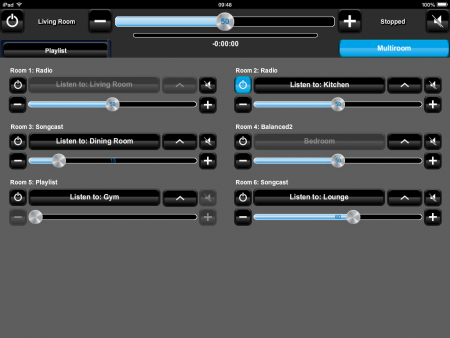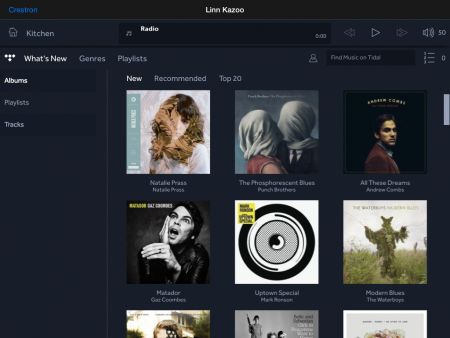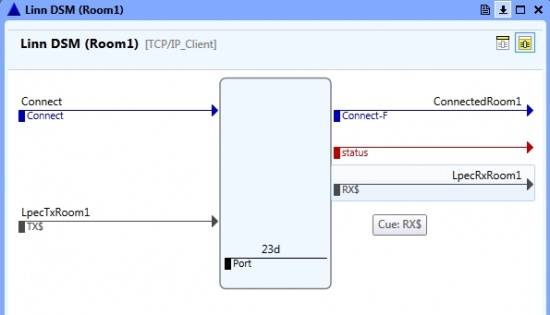Difference between revisions of "Linn Crestron Module"
(→Getting Started) |
(→LinnSimplPlusModule) |
||
| Line 65: | Line 65: | ||
==== LinnSimplPlusModule ==== | ==== LinnSimplPlusModule ==== | ||
| − | * '''LinnSimplPlusModule.usp/ush''': the Simpl+ program used for the Linn DS module. | + | * '''LinnSimplPlusModule.usp/ush''': the Simpl+ program used for the Linn DS module. |
| − | |||
| − | |||
| − | |||
| − | |||
| − | |||
| − | |||
| − | |||
| − | |||
* '''ExternalUrlSelector.usp/ush''': small helper program for jumping to various Kazoo urls. | * '''ExternalUrlSelector.usp/ush''': small helper program for jumping to various Kazoo urls. | ||
* '''LinnSimplSharpModule.clz''': compiled Simpl# code required by the Simpl+ program. | * '''LinnSimplSharpModule.clz''': compiled Simpl# code required by the Simpl+ program. | ||
Revision as of 13:39, 25 March 2015
Overview
The Linn Crestron module allows a Linn system to be easily added into a Crestron installation. It provides all basic functionality required for using your Linn DS or DSM. The module makes use of the LPEC protocol to allow your Linn device to communicate with a Crestron system.
Full source code for this module has been released and can be used as is or modified to suit any given installation.
The module was developed using a Crestron CP3 processor and will require that or better to function.
Basic Functionality
All core control functions are available for the main room:
- Standby
- Volume and mute
- Source selection
- Playback commands (play, pause, stop, skip, seek, repeat, shuffle)
- Track selection from existing playlist
- Radio selection from preset list (as well as radio next and previous)
All core feedback is provided as well:
- Album art
- Track metadata
- Track details
- Time
- Playback state
- All other states (i.e. volume, mute, standby)
Multi-room
The module also provides multi-room control for a configurable number of other rooms in the house.
- Select another room to listen to using Songcast.
- Change volume, mute and standby on all Linn devices from one place.
- Toggle which Linn device is the main room for further control.
- Tested with a six room installation but more can be added.
Kazoo Integration
- For more complicated operations (i.e. playlist creation), the module provides integration with Kazoo.
- It allows Kazoo to be opened directly to the selected room and view (i.e. music, radio, songcast, external inputs).
- It also provides an option to open Kazoo in Tidal browse mode as well.
- Kazoo is opened with a button in the top left to quickly return to Crestron.
- The module also provides the ability to open the Linn device's configuration page in a web browser or jump directly to the TuneIn website for radio preset configuration.
Download
Location
http://products.linn.co.uk/VersionInfo/Downloads/Releases/LinnCrestronModule_latest.zip
Contents
LinnSimplModule
- LinnDsModule.ct_system_x: a complete Crestron Studio project demonstrating the Linn Crestron module.
This project includes a CP3 processor, 6 rooms and a sample iPad control application (which can toggle control between the 6 rooms). The rooms will need to have static IP addresses allocated to them and entered in the system setup.
LinnSimplPlusModule
- LinnSimplPlusModule.usp/ush: the Simpl+ program used for the Linn DS module.
- ExternalUrlSelector.usp/ush: small helper program for jumping to various Kazoo urls.
- LinnSimplSharpModule.clz: compiled Simpl# code required by the Simpl+ program.
LinnSimplSharpModule
- Lpec.cs: handles the bulk of the Lpec processing required for the Linn module.
Release Notes
4.1.2 (Released 27 Jan 2015)
- Fixed bug on opening Kazoo from Crestron module when the selected room contains spaces in the room name.
4.1.1 (Released 26 Jan 2015)
- Initial release of the Linn Crestron Module.
- Includes support for all Linn products including DS and DSM at Davaar level.
- Also handles connections with legacy preamp devices (i.e. Klimax Kontrol, Akurate Kontrol, etc).
- Includes multi-room support (tested with 6 rooms but can handle more).
- Includes Kazoo URL integration (jump to Kazoo which will present a back to Crestron button).
Getting Started
Using Crestron Studio is ideal as the complete example makes everything more straightforward. However, there should be no problem using the Linn module in simpl windows.
To get you started, each Linn DS or DSM in an installation needs a corresponding TCP/IP Client device to represent it – you must supply the static IP address of the DS/M.
The device then needs to be connected as per the image below taken directly from the Crestron studio program. The signal names correspond to the signal names in the Linn module.
TCP/IP Client Linn Simpl Plus Module Type ------------- ---------------------------- ------ Connect doConnect DIGITAL_OUTPUT TX$ soLpecTxRoom[1] STRING_OUTPUT
Connect-F diConnectedRoom[1] DIGITAL_INPUT status N/C RX$ biLpecRxRoom[1] BUFFER_INPUT
You should no longer need to worry about the command format (i.e. ACTION Ds/Volume...) as the module handles this for you. To establish volume control, you would just need to use the following from the Linn simpl plus module:
aiVolume: supply an integer value to set the volume on the DS (ANALOG_INPUT) aoVolume: provides feedback from the DS as to its current volume (ANALOG_OUTPUT)
Signal Descriptions
Digital Inputs
DIGITAL_INPUT diStandbyToggle, diStandbyOn, diStandbyOff, diVolumeInc, diVolumeDec, diMuteToggle, diMuteOn, diMuteOff, diPlay, diPause, diStop, diNext, diPrev, diFwd, diRew, diShuffleToggle, diShuffleOn, diShuffleOff, diRepeatToggle, diRepeatOn, diRepeatOff, diTimeModeToggle, diRefresh; DIGITAL_INPUT diConnectedRoom[ciROOMCOUNT], diListenToRoom[ciROOMCOUNT], diVolumeIncRoom[ciROOMCOUNT], diVolumeDecRoom[ciROOMCOUNT], diMuteToggleRoom[ciROOMCOUNT], diMuteOnRoom[ciROOMCOUNT], diMuteOffRoom[ciROOMCOUNT], diStandbyToggleRoom[ciROOMCOUNT], diStandbyOnRoom[ciROOMCOUNT], diStandbyOffRoom[ciROOMCOUNT], diRoomSwapRoom[ciROOMCOUNT, ciROOMCOUNT];
Analog Inputs
aiVolume aiSource aiChannel aiTrack aiSeconds ANALOG_INPUT aiVolumeRoom[ciROOMCOUNT, ciROOMCOUNT];
Buffer Inputs
BUFFER_INPUT biLpecRxRoom[ciROOMCOUNT, ciROOMCOUNT][ciLPECRXSIZE];
Digital Outputs
DIGITAL_OUTPUT doMute, doStandby, doShuffle, doRepeat, doRadioSourceSelected, doPlaylistSourceSelected, doSongcastSourceSelected, doIsPlayable, doIsSeekable, doIsSkippable, doHasVolume, doHasProxyPreamp, doConnect; DIGITAL_OUTPUT doRoomSelected[ciROOMCOUNT], doRoomAvailableAsSongcastSender[ciRoomCount], doRoomSelectable[ciRoomCount], doMuteRoom[ciROOMCOUNT], doHasVolumeRoom[ciROOMCOUNT], doStandbyRoom[ciROOMCOUNT, ciROOMCOUNT];
Analog Outputs
ANALOG_OUTPUT aoVolume, aoSourceCount, aoSourceIndex, aoSourceIndexDeselect, aoChannelCount, aoChannelIndex, aoChannelIndexDeselect, aoTrackCount, aoTrackIndex, aoTrackIndexDeselect, aoDuration, aoSeconds; ANALOG_OUTPUT aoVolumeRoom[ciROOMCOUNT, ciROOMCOUNT];
String Outputs
STRING_OUTPUT soCurrentSource, soCurrentSender, soTime, soVolume, soRoomName, soArtworkUrl, soComposer, soTitle, soArtist, soArtistAndComposer, soAlbum, soDetails, soTransportState, soConfigurationUrl, soConfigurationUrlProxy, soKazooUrl, soKazooTidalUrl, soTuneInUrl; STRING_OUTPUT soLpecTxRoom[ciROOMCOUNT], soVolumeRoom[ciROOMCOUNT], soRoomNameRoom[ciROOMCOUNT], soCurrentSourceRoom[ciROOMCOUNT], soSourceName[ciMAXSOURCES], soChannelName[ciMAXCHANNELS], soTrackName[ciMAXTRACKS, ciMAXTRACKS];
